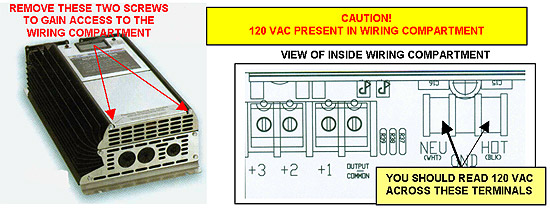Troubleshooting - Marine Battery Charger
A. Remove the screws holding the wiring compartment cover in place and remove the cover (see below).

B. Connect an AC Voltmeter to the NEU and HOT terminals. The meter should read 120 VAC, if it does not check the circuit breaker that supplies power to the battery charger. If the circuit breaker checks good and you still do not have 120 VAC Power you have a wiring problem. If 120 VAC is available at the terminals go to step C.
C. Disconnect the OUTPUT COMMON wire from the OUTPUT COMMON Terminal (see below).

D. Using a digital voltmeter, connect the NEGATIVE probe of the voltmeter to the OUTPUT COMMON Terminal, then connect the POSITIVE probe to Output Terminal +1. The voltmeter should read 13.6 Volts +/- .3 volts, if it does the #1 output is good, now move the POSITIVE probe to +2 and then to +3. If all three outputs read 13.6 volts, the charger is good. If any or all of the outputs reads zero volts check the REVERSE BATTERY PROTECTION FUSE (S) (See drawing above for their location).
E. If the REVERSE BATTERY PROTECTION FUSE (S) are blown replace them and re-test the three outputs for 13.6v. NOTE: The only thing that will blow these fuses is if the battery leads were connected in reverse. If the fuse (s) are good and there is no 13.6 volts on the output terminals the charger is defective.

